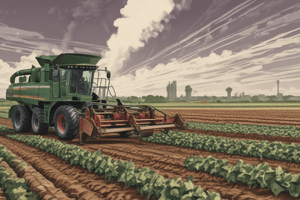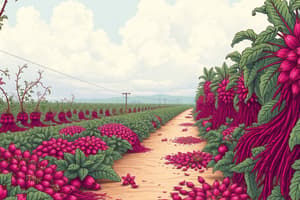Podcast
Questions and Answers
What is the process of extracting sugar from beet called?
What is the process of extracting sugar from beet called?
Diffusion
What is the name given to the sugar beet processing stage where impurities are removed from the raw juice?
What is the name given to the sugar beet processing stage where impurities are removed from the raw juice?
Juice Purification
In what process is the thin juice concentrated to make a thick juice?
In what process is the thin juice concentrated to make a thick juice?
Multiple-effect evaporation
What is the primary fuel source for boiler furnaces in sugar cane mills?
What is the primary fuel source for boiler furnaces in sugar cane mills?
What is the name given to the thick sugar syrup containing sugar crystals produced in vacuum pans?
What is the name given to the thick sugar syrup containing sugar crystals produced in vacuum pans?
The final syrup from which it is not economical to extract more sugar is called molasses.
The final syrup from which it is not economical to extract more sugar is called molasses.
What are the machines called that are used to separate sugar crystals from syrup in the sugar production process?
What are the machines called that are used to separate sugar crystals from syrup in the sugar production process?
What is the name given to the process of turning sugar syrup into a crystalline form by boiling off water under reduced pressure?
What is the name given to the process of turning sugar syrup into a crystalline form by boiling off water under reduced pressure?
What is the byproduct of sugar production that is used as fertilizer or growth substrate for yeast cultures?
What is the byproduct of sugar production that is used as fertilizer or growth substrate for yeast cultures?
The counter-flow principle in diffusion ensures that hot water flows in the same direction as the cossettes.
The counter-flow principle in diffusion ensures that hot water flows in the same direction as the cossettes.
What is the approximate sugar content of the thin juice before entering the evaporators?
What is the approximate sugar content of the thin juice before entering the evaporators?
What is the approximate sugar content of the thick juice after leaving the evaporators?
What is the approximate sugar content of the thick juice after leaving the evaporators?
What is the typical size of sugar crystals in massecuite?
What is the typical size of sugar crystals in massecuite?
What is the by-product of sugar crystal separation in the centrifugals?
What is the by-product of sugar crystal separation in the centrifugals?
What is the name given to the process of crushing sugar cane to extract juice?
What is the name given to the process of crushing sugar cane to extract juice?
What is the name given to the fibrous material separated from the juice during sugar cane processing?
What is the name given to the fibrous material separated from the juice during sugar cane processing?
What is added to the limed juice to neutralize acids and precipitate impurities during sugar cane processing?
What is added to the limed juice to neutralize acids and precipitate impurities during sugar cane processing?
What is the name given to the process of concentrating sugar syrup by boiling it under vacuum?
What is the name given to the process of concentrating sugar syrup by boiling it under vacuum?
What is the name given to the large vessels where sugar syrup is concentrated by boiling under vacuum in the sugar cane processing chain?
What is the name given to the large vessels where sugar syrup is concentrated by boiling under vacuum in the sugar cane processing chain?
What is the name given to the process of separating sugar crystals from syrup using centrifugals?
What is the name given to the process of separating sugar crystals from syrup using centrifugals?
What is the approximate sugar content of the syrup before it is concentrated in the vacuum pan during sugar cane processing?
What is the approximate sugar content of the syrup before it is concentrated in the vacuum pan during sugar cane processing?
What is added to the syrup in the vacuum pan to initiate crystallization?
What is added to the syrup in the vacuum pan to initiate crystallization?
Flashcards
Sugar Beet Harvesting
Sugar Beet Harvesting
The process of harvesting sugar beet from the field, starting around the end of September and continuing till mid-January.
Mechanical Harvesting
Mechanical Harvesting
A mechanical process that not only pulls the sugar beet from the ground but also cleans it and removes the tops.
Beet Tops
Beet Tops
The leaves of the sugar beet plant, a valuable source of animal feed.
Weighing and Sampling
Weighing and Sampling
Signup and view all the flashcards
Tare
Tare
Signup and view all the flashcards
Farmer Payment
Farmer Payment
Signup and view all the flashcards
Reception Area
Reception Area
Signup and view all the flashcards
Soil Tare
Soil Tare
Signup and view all the flashcards
Crown Tare
Crown Tare
Signup and view all the flashcards
Sugar Content
Sugar Content
Signup and view all the flashcards
Nitrogen Content
Nitrogen Content
Signup and view all the flashcards
Unloading Methods
Unloading Methods
Signup and view all the flashcards
Silos
Silos
Signup and view all the flashcards
Wet Unloading
Wet Unloading
Signup and view all the flashcards
Stone and Grass Catchers
Stone and Grass Catchers
Signup and view all the flashcards
Diffusion
Diffusion
Signup and view all the flashcards
Cossettes
Cossettes
Signup and view all the flashcards
Diffuser
Diffuser
Signup and view all the flashcards
Raw Juice
Raw Juice
Signup and view all the flashcards
Pulp
Pulp
Signup and view all the flashcards
Juice Purification
Juice Purification
Signup and view all the flashcards
Milk of Lime
Milk of Lime
Signup and view all the flashcards
Carbonatation
Carbonatation
Signup and view all the flashcards
Chalk
Chalk
Signup and view all the flashcards
Thin Juice
Thin Juice
Signup and view all the flashcards
Evaporation
Evaporation
Signup and view all the flashcards
Evaporators
Evaporators
Signup and view all the flashcards
Thick Juice
Thick Juice
Signup and view all the flashcards
Crystallization
Crystallization
Signup and view all the flashcards
Vacuum Pans
Vacuum Pans
Signup and view all the flashcards
Massecuite
Massecuite
Signup and view all the flashcards
Centrifugals
Centrifugals
Signup and view all the flashcards
Molasses
Molasses
Signup and view all the flashcards
Study Notes
Sugar Process, Technology, and Related Products
- Sugar production involves processes for both sugarcane and sugar beets.
- The 2009 Top Ten Sugar Beet Producers, in metric tons, were: France (35.2 million), United States (27 million), Germany (25.9 million).
Sugar Beet Processing
- The process begins with harvesting sugar beets.
- The beets are washed and sliced.
- Impurities are cleaned from the juice.
- Sugar is crystallized from the syrup.
- Sugar crystals are dried.
Sugar Beet Production
- Harvesting occurs from late September to mid-January.
- Mechanized methods are used (cutting off tops, extracting roots).
- The leaves are used as animal feed.
- Beets are transported via lorries to processing factories.
Weighing and Sampling
- Beet weight is measured accurately at the factory.
- Samples are taken to determine sugar percentage and tare.
- Tare includes stones and beet byproducts which are deducted from the total weight.
Reception
- Each load is weighed and sampled before being placed in heaps.
- Soil tare, crown tare, and sugar and nitrogen content are checked.
- The sugar content of each load is calculated based on these elements.
- Beets are moved into a channel, then washed, headed for the processing plant.
Unloading
- Two systems are used for unloading: dry and wet.
- Dry unloading uses conveyor belts to silos.
- Wet unloading uses water jets, cleaning the beets.
- Stones and grass are removed using a series of stone and grass catchers.
- Beets are washed before proceeding.
Diffusion
- Sugar is extracted from sliced beets by diffusing with hot water.
- Beet slices are continuously fed in and out.
- The extracted juice is separated from the pulp.
- The pulp is dried and used as animal feed.
- Raw juice is around 14% sugar and black.
Extraction
- Sugar is extracted from cossettes through the use of hot water.
- The juice contains about 98% sugar.
- The process is called counter-flow extraction, with the water's flow opposite to the cossettes.
Water Thermostat
- The water temperature is maintained during extraction.
Evaporation
- The purified juice is concentrated from 14% to 60% sugar by boiling off water in evaporators.
- Evaporators are large vessels.
Evaporation (Continued)
- Concentrated juice is created through multiple effect evaporation, producing a thick syrup similar to pancake syrup.
- This thick syrup is stored in tanks, to reduce the load on the crystallization plant.
Crystallization
- Recycled sugar is dissolved into thick juice.
- Sugar crystals form, with syrup (mother liquor) around them.
- This is called massecuite.
- The liquid is separated from the crystals by centrifuging.
- Crystals are dried in a granulator.
- A second batch of sugar may be produced, of lower quality.
Centrifugals
- The sugar is separated from the syrup using centrifugals.
- The wet sugar is dried, screened, cooled, and sent to large storage silos (up to 50,000 tonnes).
- Molasses is the final syrup.
- The process takes around 12 hours, with beet producing 12-14 tonnes of sugar and 3-4 tonnes of molasses per 100 tonnes.
Additional information
- White sugar centrifugals are for recovering sugar crystals.
- The pages include diagrams, images, and maps, but these aren't explicitly requested in the general notes and therefore omitted.
Studying That Suits You
Use AI to generate personalized quizzes and flashcards to suit your learning preferences.




